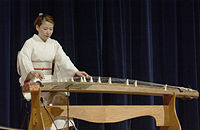Koto (musical instrument)
The koto (Japanese: 箏, Sino-Japanese reading "sō"; more commonly, though not quite correctly, the character 琴, Sino-Japanese reading "kin" is used) is a traditional stringed musical instrument from China resembling a zither.
Koto are about 180 cm long and have 13 strings that are strung tautly across 13 movable bridges along the length of the instrument. Players make base pitches by moving these bridges before playing, and use three finger picks (on thumb, forefinger, and middle finger) to pluck the strings.
The koto was introduced to Japan in the 7th to 8th century from China, and largely derived from the Chinese guzheng. It was initially played only in the royal court, but this situation changed in the 17th century — primarily because of the influence of Yatsuhashi Kengyo (1614-1684).
Yatsuhashi Kengyo was a blind shamisen player who learned koto from an "official" court player named Hosui, in defiance of the rules which then stated that koto could not be taught to blind people (or women, incidentally). Possibly because of his personal experience with these restrictions, Yatsuhashi spent the rest of his life making the koto more accessible.
He invented a new "plain tuning" (hira jōshi) to play the common peoples' songs more naturally. He composed (or is credited with composing) songs that are still irreplaceable staples of the koto repertoire today, including Rokudan and Midare. (These compositions were partly responsible for the koto becoming respected as a solo instrument in its own right.) Perhaps most importantly, his example led other non-elite, including women, to learn the koto too.
Since the Japanese music scene was made over in Western pop music's image, the koto has become less prominent (although many well-to-do young women learn the instrument to help develop an aura of "refinement" that will theoretically attract a better class of husband). However, it is still developing as an instrument; works are written for and performed on 20-stringed and bass kotos, and a new generation of players such as Sawai Kazue, Yagi Michiyo (who studied under Sawai) are finding places for the koto in today's jazz, pop and even experimental music. June Kuramoto, of the jazz fusion group Hiroshima, was one of the first koto performers to popularize the koto in a non-traditional style. David Bowie used the koto in the instrumental piece "Moss Garden" on his album "Heroes". Other performers outside of Japan include koto master and award-winning recording artist Elizabeth Falconer, who also studied for a decade at the esteemed Sawai Koto School in Tokyo, as well as koto master Linda Kako Caplan, the sole Canadian representative of Fukuoka's Chikushi Koto School for over two decades. David Horvitz pioneered the instrument into the contemporary indie rock scene playing on Xiu Xiu's new album, The Air Force.
Koto also come in larger sizes, the most popular of which is the 17-string bass koto.
External links
- Reiko Obata - koto performer in California and information on the koto
- Detailed history of the instrument
- Articles on Koto Masters Sawai Tadao and Sawai Kazue
- Article on Koto Master Chikushi Katsuko
- Linda Kako Caplan - The World of Japanese Koto and Shamisen - Linda Kako Caplan - The World of Japanese Koto and Shamisen : textbooks, CD and online video resources for koto, plus useful links and general info on the instruments
- Koto World.com - Koto World : online CD store and koto information site
- Koto no Koto - Koto no koto: the website with ALL the info you need about US and Canadian teachers, recordings, and the instrument.
- [1] Enjoy Japanese Music.com - Website of the koto/shakuhachi duo EN.
- O-koto Culture of Japan Play the "Sakura" tune on a virtual koto.
- New koto – Doremi Pop Corn.
Bibliography
- The Koto: A Traditional Instrument in Contemporary Japan, by Henry Johnson (Hotei, 2004).
- The Kumiuta and Danmono Traditions of Japanese Koto Music, by Willem Adriaansz (University of California Press, 1973).
Buy a koto
ar:كوتو de:Koto es:Koto fr:Koto it:Koto nl:Koto (instrument) ja:箏 pl:Koto pt:Koto ru:Кото fi:Koto
Credits
New World Encyclopedia writers and editors rewrote and completed the Wikipedia article in accordance with New World Encyclopedia standards. This article abides by terms of the Creative Commons CC-by-sa 3.0 License (CC-by-sa), which may be used and disseminated with proper attribution. Credit is due under the terms of this license that can reference both the New World Encyclopedia contributors and the selfless volunteer contributors of the Wikimedia Foundation. To cite this article click here for a list of acceptable citing formats.The history of earlier contributions by wikipedians is accessible to researchers here:
The history of this article since it was imported to New World Encyclopedia:
Note: Some restrictions may apply to use of individual images which are separately licensed.
